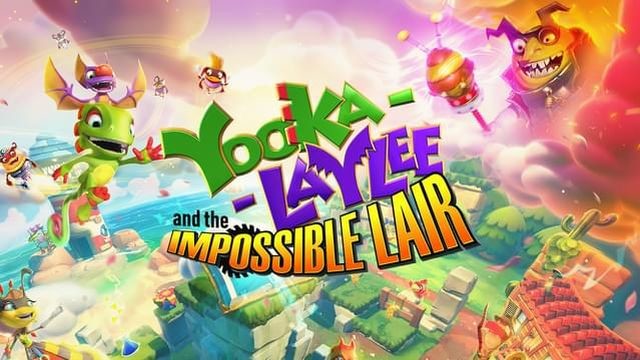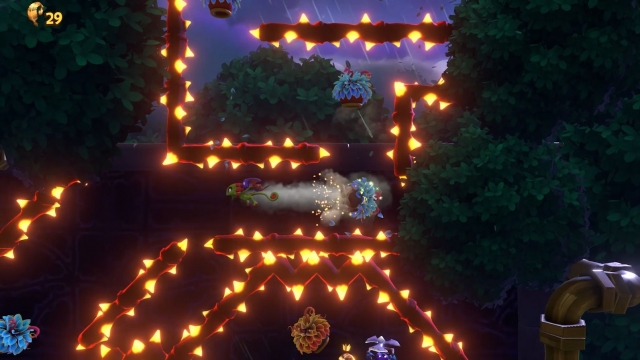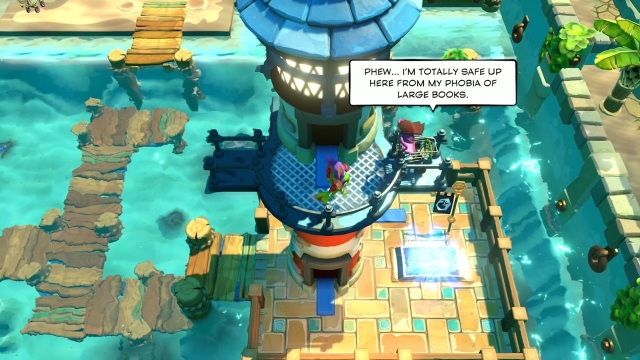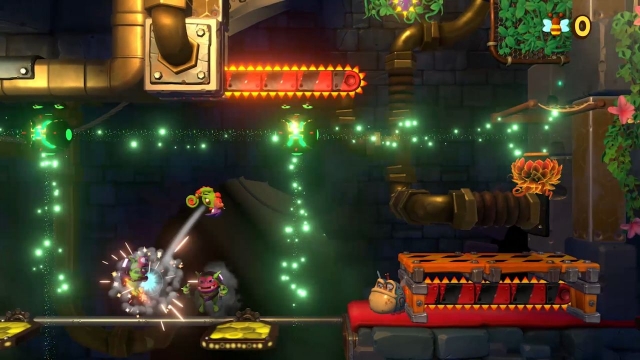Yooka-Laylee and the Impossible Lair

The original Yooka-Laylee was an early crowdfunding darling that set out to recapture the feeling of just what made Banjo-Kazooie work. The team at Playtonic Games was made up of a lot of Rareware veterans and they did their best to create something on-par with those 64-bit classics. When it came to humor, they definitely hit the mark, but the core game was a bit off. The platforming was solid, but there were too many kinds of mini-games and collectibles – on par with Banjo-Tooie where everything just becomes a chore to grab and explore. Fortunately, the team was receptive to criticism and opted to go for a more simplified approach with The Impossible Lair. Instead of a large-scale 3D game, we get a more focused 2D side-scrolling platformer akin to the original Donkey Kong Country series and not the Returns series.
Some may wonder just why this is needed with the Returns games out there, but one big key to the DKC games is teamwork and another big part is the flow of their levels. The Returns games have multiple characters, but the feeling of a two-character team-up helping out and allowing you to access new areas isn’t there since the extra characters in Returns basically act as extra hit points with different play styles. The flow of stages is also vastly different and isn’t as reliant on fast movement and momentum due to a stop and start design and an increase in character weight changing how jumps feel – especially trickier ones where being off a little bit can send you into the abyss.
The Impossible Lair keeps the same kind of fast flow that made the DKC games so fun and feels like what I always imagined the Returns games being – with some new wrinkles thrown in. You can’t switch between Yooka and Laylee on the fly, but Laylee does allow you to get a longer flight path for jumps ala Dixie’s hair helicopter, and she can also use her tongue to grab objects. The core game has a bit of Zelda-esque key-grabbing and usage to open up secret areas and grab more goodies. Nabbing five coins in each variant of a level ensures that you will be able to make smooth progress as there is an in-game paywall using these coins.
Trowzer the snake is back at it and despite the green and purple duo being the only thing that can save the land from more of Capital B’s carnage, he can’t help but use his greed to try and profit off of things. It’s a bit annoying, but also right in line with the DK coin-gating used in DKC 2. The game’s overworld setup is incredible and while the original DKC and DKC Returns used them as straight A-to-B setups, ILR goes after more of the DKC 3 design of being wide open and full of secret areas. One big difference is that there is some platforming thrown in alongside some overhead Zelda-style sections. These areas caught me completely off-guard as I knew the world had some interactive elements, but never figured we would get not only something that crafted new DKC-style memories, but also paid homage to the early Zelda games in a way I’ve never seen something as seemingly small as an overworld do.
The Impossible Lair is among the finest 2D platformers on the market today, and thanks to the re-release of DKC Returns: Tropical Freeze, it’s clear to see just how much better this game works as a DKC send-up than the actual DKC Returns games did. The Donkey Kong Country Returns games do a better job of looking the part due to having the characters – but The Impossible Lair does a far better job of playing the part because it nails the feel of the core action. Moreover, TIL does some cool things that aren’t done very often – like allowing you to use overworld pickups to change the nature of the stages you’re in.
You have the ability to grab ice bombs and freeze stages – offering up a whole new challenge. Beyond the sheer look of everything being covered in ice, the ice physics offer up an NES hard-level of challenge when it comes to your timing. This can be frustrating, but the game doesn’t punish you with death much beyond losing some easily re-obtained quills and if you really get stuck, you can just select to skip an area. This is a bit different than Nintendo’s option of showing you a playthrough video and letting you take over as you still have to learn the mechanics if you want to play through it – offering up a nice in-between as you can still avoid frustration in the short-term and learn things later on. Having anti-frustration features like this is nice and helps prevent player burnout. Beyond just icing up stages, you can also change the height of some areas and even use in-game tonics to do things like change the look of the game to look much older and thus make it a bit tougher, or just have things that keep Laylee around on-screen longer after she’s knocked off your shoulders from an attack. In that sense, she acts a bit more like Yoshi here.
Visually, The Impossible Lair is a stunner. It uses the same art style as the original and features the same kind of lushly-detailed environments and character models. Animation is also fluid and allows for picture-perfect timing during tough areas. The change in environments allows for stages to both look familiar and now as an area can go from being bathed in bright Earth tones under normal conditions to then being caked in layers of ice and snow that completely change the appearance and feel of the environment. The frame rate is consistently smooth and that’s a must given how exact your timing has to be during tough challenges. Overall, there’s nothing wrong with the appearance of The Impossible Lair, and the same holds true for the sound as a whole.
Once again, Rare veterans return for a soundtrack that not only fits the world, but keeps you hooked from stage to stage. Most of the core levels have bright and chipper music that changes to slow and somber as the pace slows. When things crank up, so does the tempo as barrel blast-style sections result in rapid-fire beats that keep your blood pumping. The sound effect work is largely great too – although the usage of the Banjo-Kazooie-esque garbled sped up speech is once again done poorly like in the original, resulting in something that simply isn’t pleasant to the ears no matter how cute of an homage it is to the past. Luckily, everything else about the sound design easily triumphs over a small shortcoming like that.
Yooka-Laylee: The Impossible Lair manages to outshine the franchise’s debut effort in every major way. The game’s design remains open to an extent, but greatly focuses in on what you need to do – cutting down on a lot of busy work. The fast-paced action feels perfect and manages to out-Donkey Kong Country the Returns series as a result of nailing the pacing that made the original DKC trilogy so addicting on the SNES. The action meshes perfectly with the lush graphics and robust soundtrack to create one of the finest side-scrolling platformers on the market today. The Impossible Lair is a must-buy for any platforming fan.
Reviewed By: Jeremy Peeples
Publisher: Team17
Rating: 95%
——————————————————————————–
This review is based on a digital copy of Yooka-Laylee and the Impossible Lair for the PlayStation 4 provided by Team17.
 Game Over Online
Game Over Online









